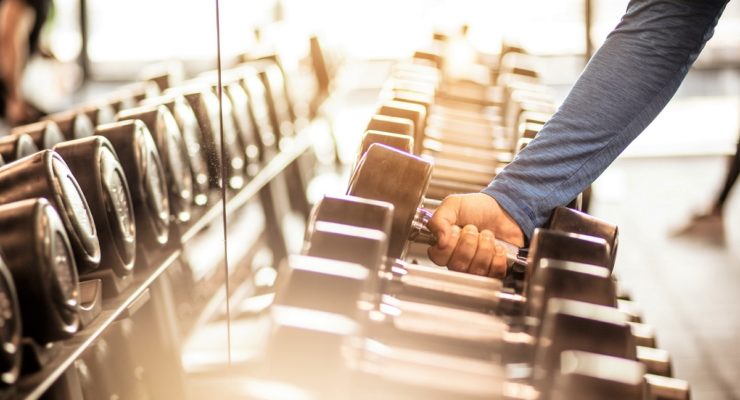Looking good is great, and as good a reason as any to get in shape. But feeling great is even better. Keeping up with your kids, an increased stamina and smiling in strength rather than wincing in pain are all amazing rewards. And the commitment to moving your body is more important every year.
That’s because as we age, our bodies start to, well, change. As men hit their late 30s and early 40s, testosterone levels fall one- to two-percent per year. Your bones, while not as susceptible to osteoporosis as women, become weaker and more susceptible to breaking.
You lose muscle, too—as much as three to five percent per decade after age 30. According to Harvard Health Publishing, “Most men will lose about 30% of their muscle mass during their lifetimes.”
And, of course, we stiffen up: According to the National Institutes of Health, about 80 percent of adults experience lower back pain during their life. So we sit a lot more—and that can increase the risk of heart attack and stroke.
All of that can sound scary, but it’s not—because there’s a way to potentially alleviate all of these age-related changes to our body: Getting (and staying) in shape. Use these five fitness tips specifically designed for men to combat the changes as you age and start feeling fantastic.
1. First Thing’s First: You NEED to Warm Up!

One of the most important fitness tips for getting and staying in shape isn’t a specific workout or a special exercise: The real number one key is not getting injured. And one of the key ways to keep from getting injured is to warm up.
Yes, yes, warming up is boring, and you never did it as a kid. You just dropped your stuff and sprinted out onto the court or field. But getting your body primed for exercise has been shown in studies to keep you on the field or in the gym for longer. In one study of fitness instructors, those who warmed up before their classes had lower rates of injury. And the longer they warmed up, the less likely they were to be injured.
We’re not talking about stretching here. A warmup should literally “warm up” the body: According to a review of research, published in Sports Medicine, warming up has many benefits. “It has been shown to increase the speed and force of muscle contractions. The muscles become less viscous, which results in smoother contractions.” explains the researchers. “Finally, it has been reported that a warm-up provides a protective mechanism to muscle by requiring a greater length of stretch and force to produce a tear in the warmed muscle.” This may help prevent injuries.
You don’t need to bring a thermometer, though. A proper warm up should produce a mild sweat without tiring you out. Before you start a harder workout session, spend five to 10 minutes increasing your heart rate with simple moves like high-knee marching, light jogging and jumping jacks, and move your joints through their full range of motion. Do arm circles, leg circles and swing your hips and arms around a little.
2. Make Sure You Stay Consistent: Embrace Short Workouts

If ingredient one in a recipe for long-term fitness is fending off injury, ingredient two is consistency. It’s a cliché because it’s true: As long as you’re not getting hurt, a bad workout done consistently is better than a great workout done every once in a while.
One way to make that easier for yourself: Make each workout session shorter. While the Centers for Disease Control and Prevention says that you should do 150 minutes of cardiovascular exercise per week, to reduce risks of cardiovascular disease, diabetes and premature death, you don’t have to do all 150 minutes at once—you can do 15 sessions of 10 minutes each and get the same benefits!
Check out these suggestions for exercise options that take 10 minutes or less, or create a few of your own. Go for a 10-minute walk at lunch, then do 10 minutes of basic calisthenics later in the day—pushups, sit-ups, jumping jacks or other exercises you already know. Just like eating, creating small habits you can consistently do every day—instead of relying on one or two “perfect” meals—can really add up in your exercise routine.
3. Maintain Your T: Fight Body Fat by Changing Your Cardio

Cardio for testosterone? Believe it: While you’ve heard that lifting heavy weights helps with testosterone levels, that effect is largely acute—your body bumps up your T levels right after the workout, but this doesn’t result in a chronic, long-term bump in testosterone levels.
But a lower body fat percentage might. According to research, higher fat mass in men is associated with lower “free testosterone,” the kind that’s there all the time, in the long-term. You can decrease your body fat percentage by changing your nutrition, of course, but also by switching up your cardio routine. Instead of focusing on medium-effort, steady-state work—a long, slow jog, or a consistently-paced walk—alter your pace throughout the cardio session. Alternating bouts of fast and slow work in a cardio session (commonly referred to as interval training) has been shown in multiple studies to help people lose more body fat than steady-state exercise.
Try this: Set a timer to repeat for one or two minutes during your next walk or jog. Go slightly faster for one to two minutes—just enough so your effort level ticks up—and then slow back down for one or two minutes. Keep alternating in this way for your whole session.
4. Battle Against Muscle and Bone Loss: Add Some Weight

You don’t have to lift super heavy weights to maintain muscle. In one study, scientists found that men who lifted 75- to 80-percent of their maximum for sets of eight to 12 repetitions had similar gains in strength and muscle size as other men who lifted 30- to 50-percent of their maximum for sets of 20 to 25.
Translation: You can use lighter weights, and still gain muscle. The efforts just still have to wear you out: Those longer sets of 20 to 25 worked because they brought the men in the study near muscular failure—where they couldn’t do much more—in the same way that lifting the heavier weights for fewer reps did, too.
When you lift, you’ll strengthen your bones, too. According to Harvard Health Publishing, “Numerous studies have shown that strength training can play a role in slowing bone loss, and several show it can even build bone.” Researchers explain that the stress certain activities put on the bones can “nudge bone-forming cells into action.”
Get both benefits for lots of your muscles with a simple move: The farmer’s carry. Grab a pair of dumbbells and stand with them at your sides with your chest proud and shoulders back. Walk forward holding the dumbbells, maintaining this tall posture. Start by doing three to four walks of 20 or so feet. Put the dumbbells down to rest for about 30 seconds between each 20-foot carry.
5. Undo Some Chair Damage: Loosen Up Your Thoracic Spine

American adults are sedentary for an average of six to eight hours per day. According to the American Heart Association, this sedentary behavior includes activities like sitting, driving and screen time, such as watching TV and using the computer. All of this time sitting could spell trouble for your ticker: Research shows that sitting for longer periods of time can impact your health and is associated with chronic diseases like heart disease, Type 2 diabetes and cancer.
And all our sitting is hurting more than our hearts: It’s tightening up our hips and back, too, making us less likely to want to exercise. And while many people wind up with pain in their lower back, it’s often immobility in the center of the spine—called the thoracic spine—that can lead to the ouch in their lumbar spine.
The American Council on Exercise (ACE) provides several moves that can help you increase mobility in your thoracic spine. One of these is super simple. Stand up straight and step your right food behind you about one stride length. Remain on the ball of the right foot with your heel lifted off the ground. Bend your right elbow 90-degrees while you keep your left arm straight and your fingers pointed to the floor. “Reach the right arm overhead while laterally flexing the spine (toward the left) to feel the length through the right side body,” says ACE. “Continue this motion before switching to the left side.”
Pair your fitness routine with a convenient weight loss plan designed for men! Nutrisystem delivers your favorite foods made healthier, directly to your door. Join today to start losing weight and feeling great! >
*Always speak to your doctor before starting a new exercise routine.
The post 5 Men’s Fitness Tips to Get You in Shape appeared first on The Leaf.
from The Leaf https://ift.tt/3qU5bpw




No comments:
Post a Comment